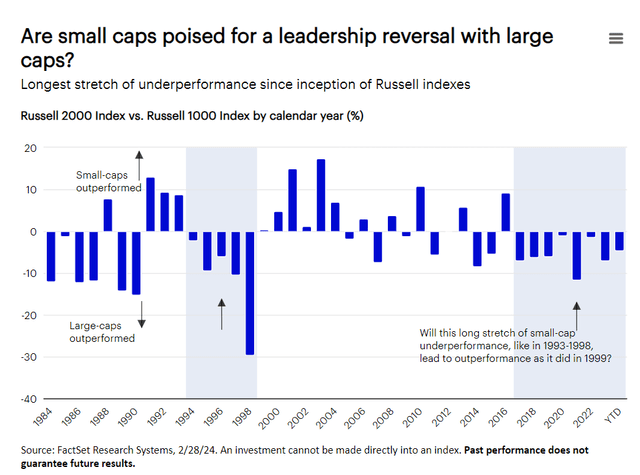The stage could be a set for a recovery in small- and mid-cap stocks. Why? If interest rates have peaked and a pattern of lower interest rates emerges over the next few years, it should bode well for small-cap stocks. Lower interest rates can lower financing costs and loosen up the availability of credit, which can help level the playing field between small- and larger-capitalization stocks.
This potential backdrop should help claw back some of small- and mid-cap underperformance relative to large caps, according to our small- and mid-cap experts, Jonathan Edwards, Senior Portfolio Manager, Invesco Value Opportunities Fund, Justin Livengood, Senior Portfolio Manager, Invesco Discovery Mid Cap Growth Fund, and Matthew Ziehl, Portfolio Manager, Invesco Main Street Small Cap Fund. They share their outlooks and the opportunities in this market segment.

Uncovering opportunities and managing risk through active management
Jonathan Edwards, Invesco Value Opportunities Fund: Excellent investment opportunities are abundant for active managers in the small- and mid-cap universe, in our view. Many of these stocks are under researched relative to larger-cap stocks. We see significant dispersion in valuation opportunities and business quality. For example, some companies have lower valuations because their earnings are temporarily depressed during the bottom of a business cycle. Or they may look overvalued on a price-to-earnings basis but look more attractive on a go-forward basis as earnings inflect higher. Furthermore, we feel we can diversify across sectors compared to a passive approach, which tends to be concentrated in certain sectors such as financials (particularly banks) and REITs.
Justin Livengood, Invesco Discovery Mid Cap Growth Fund: We’re very excited about the innovation economy that’s impacting industries across sectors. The small- and mid-cap growth universe is where the majority of these companies reside, in our view. Given the riskier nature of these smaller-sized, high growth companies, however, we believe active management can identify a select number of the best opportunities. We also seek to better manage the inherent risks versus a more passive approach.
Matthew Ziehl, Invesco Main Street Small Cap Fund: The elevated risk profile of the smaller-cap universe of stocks, in general, relative to larger caps, makes being selective important. You need active management for that.
We start with a universe of roughly 2,000 companies. (An investor would get exposure to all of those companies from an index fund that tracks the Russell 2000 Index). We then narrow it down to a portfolio of 90-100 companies that we feel have the best management teams, competitive positioning, and reasonable valuation. Improving market share and profitability and navigating within an ecosystem that, in many cases, is dominated by larger companies is key for small-cap companies to create shareholder value over a multi-year period.
The real opportunity for small-cap investing, in our view, comes from our ability as active managers to be extremely selective in finding companies that are well-managed and best-positioned to create value over time.
Small- and mid-cap opportunities they’re most excited about
Jonathan Edwards: Our investment process is designed to take advantage of long-term investment opportunities that arise when investors’ short-term focus and fears cause a company’s stock price to trade at a significant discount to our estimate of its intrinsic value. We’ve recently been finding a lot of opportunities across multiple industries in the technology sector, where many companies have been experiencing subpar financial results in recent quarters due to inventory destocking in their customer base. Most of these companies have solid return on invested capital (ROIC), attractive free cash flows, and exciting growth prospects. Despite this, many investors have sold or neglected these companies’ stocks due to concerns about weak near-term financial results. We take the long-term view and believe our investors will be rewarded when these companies’ financial results return to normalized levels and long-term earnings growth resumes.
Justin Livengood: We focus on premier growth companies that have durable competitive advantages and great management teams. We also look for companies with secular growth characteristics that benefit from emerging trends in the economy.
In our small- and mid-cap portfolios, we’re currently finding a lot of opportunities in the industrials sector. The growth of artificial intelligence (AI) and cloud computing requires substantial investment in our country’s infrastructure (e.g., data centers, electrical grid and power). Many smaller industrial companies are providing services and equipment to enable this buildout.
We also see good investment opportunities in the US housing market as new home construction continues to grow rapidly. We own several homebuilders and suppliers of building products in our portfolios.
Finally, the trucking industry is going through a variety of competitive changes, and we own some of the truckers that are gaining market share. It’s an industry that has become more stable and less cyclical than in the past, which makes it a more compelling investment.
Matthew Ziehl: We’re excited about biotechnology in general, although we remain structurally underweight in the industry. The sector has underperformed during the past few years, but assuming funding for biotechnology companies continues to improve and interest rates decline, it’ll provide a better setup for biotech stocks. Also, most large pharmaceutical companies are flush with cash and need to fill their pipelines. This can create a higher likelihood of potential merger and acquisition activity of biotech companies with exciting new drugs.
Are Small- And Mid-Sized Companies Primed To Outperform? by Invesco US
Editor’s Note: The summary bullets for this article were chosen by Seeking Alpha editors.
Read the full article here


